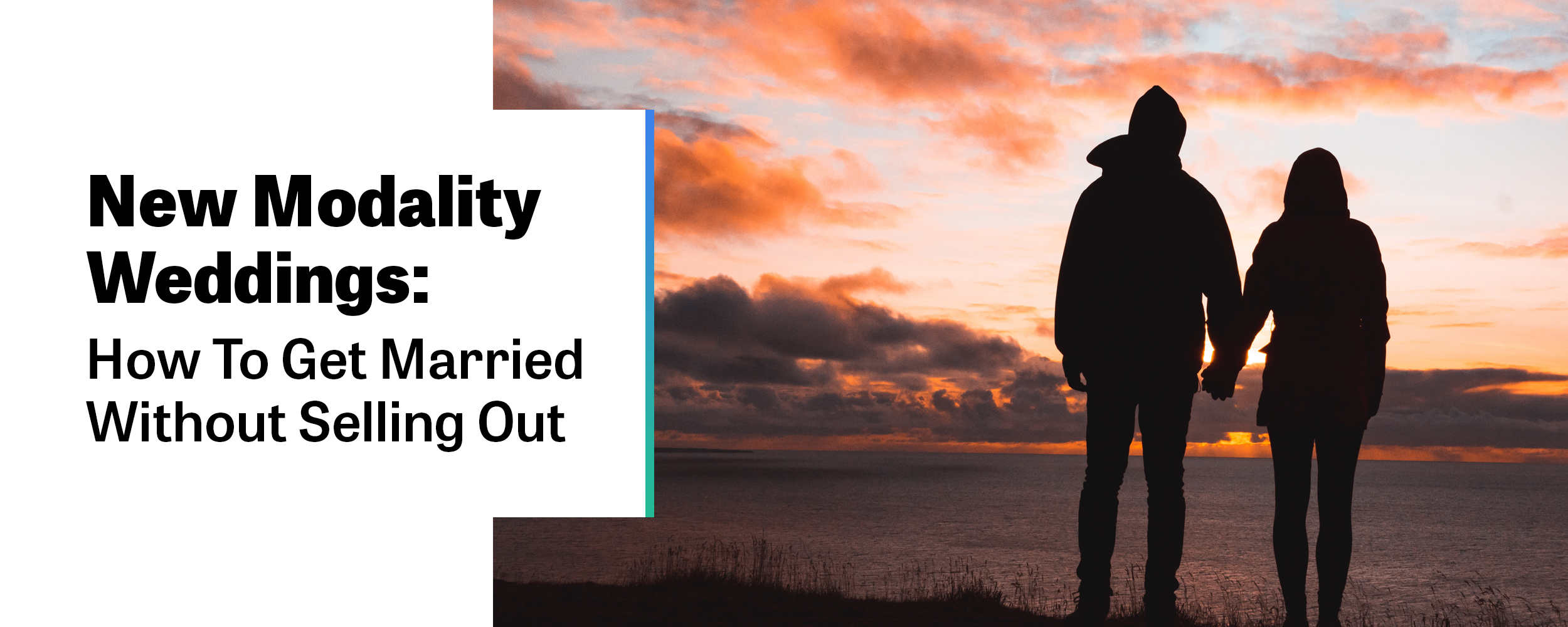
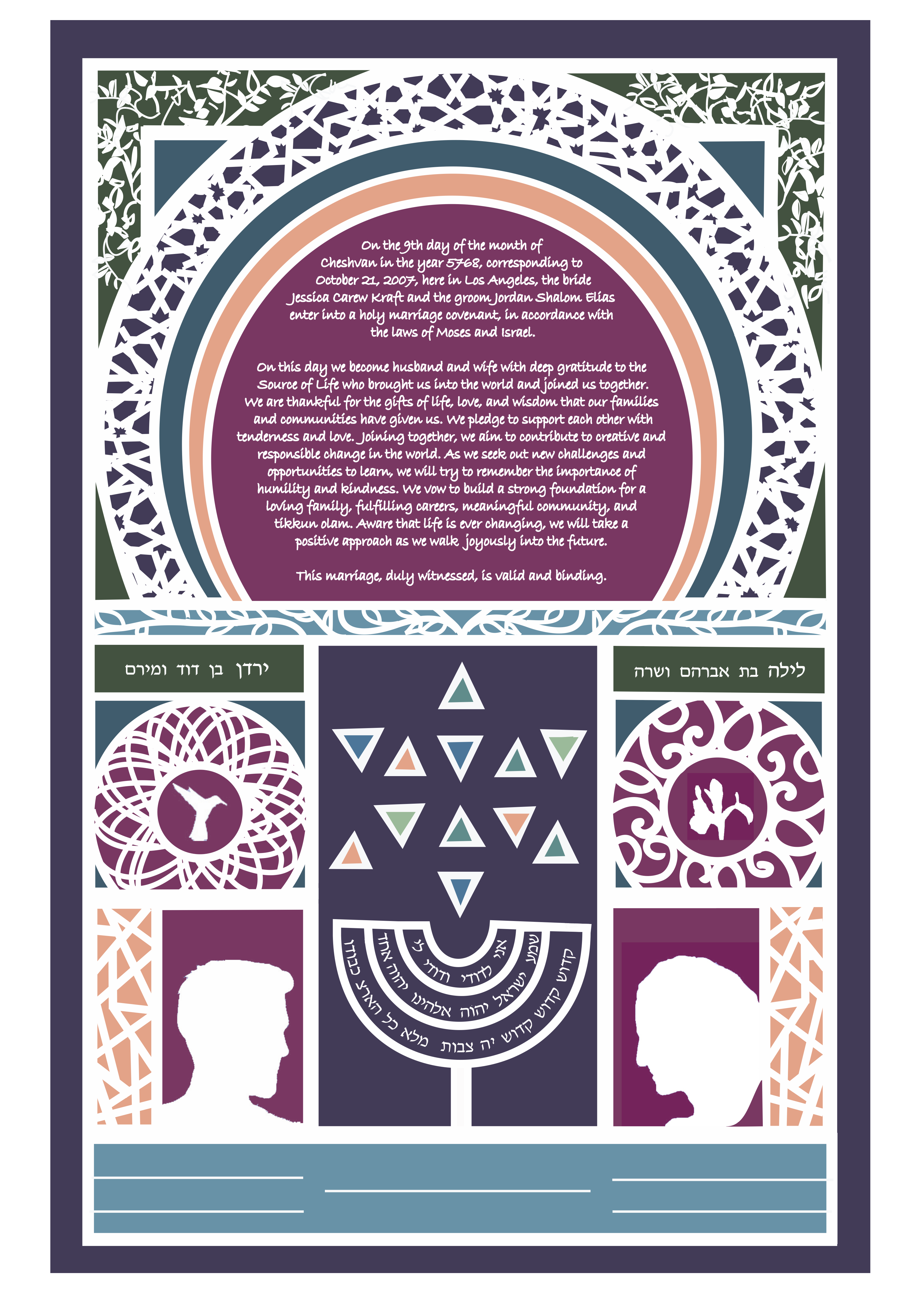
The writer's ketubah
I got married in 2007. From engagement to honeymoon, I protested the standard heterosexual conventions, but one tradition I accepted with modifications was the Jewish marriage contract, or ketubah. This is an ancient document, dating back at least 2,500 years, originally developed to protect the bride and clearly state the groom’s obligations for her basic needs. Our contemporary twist on Aramaic legalese transformed the ketubah into a beautifully illustrated commemoration of newlywed promises. No goat sacrifice necessary.
Working together on our ketubah gave my husband-to-be and I a chance to compose a mission statement that would hang on our wall for eternity (or so we believed at the time). We threw ourselves into making it a masterpiece. Though we moved three times and experimented with non-monogamy (during which the ketubah was stored away for a short time, so as not to intimidate other potential partners), it mostly remained on our bedroom wall through thick and thin. There we were, our silhouetted profiles bowing toward one another, a decorated arch between us vowing that we will strive for positivity, that we will build a home filled with light, love and laughter.
Now, 12 years since my own big day, I know a lot more about how most weddings relate to marriage. TL;DR — they don’t. At all.
We started out as equals — two autonomous, educated professionals who delighted in the idea of building a family. He’s a lawyer, I’m a writer/artist. We believed we were good at communicating and negotiating conflicts. We never thought to ask questions like the ones the New York Times prescribes to nearlyweds, such as what our money hangups were, or how we’d split up labor if we had kids.
Our fundamental pain point was how easily we fell into typical gendered patterns. He is a work-bound man and I became, reluctantly, a home-bound female. This pattern was triggered by the urgencies of breastfeeding, and continued because of the disparity in our incomes. The resentment I felt about how my career had been buried in diapers and school applications, while he ascended ladders of achievement, meant that I no longer felt that we shared the common mission we had committed to in our ketubah.
Visually, when I made the ketubah, I allotted equal space for each of us in the design. We shared and collaborated in a mutually gratifying way to create the text. But when it came to building our family, we had separate and unequal jobs.
And so, through two children with extremely difficult births, the deaths of family members and friends, dips and slides into depression and anxiety, career failures and triumphs, my spouse and I confronted that looming chasm between the grandiose expectations with which we embarked on our journey and the day-to-day drudgery of running a household. Eventually, after over a decade of marriage, we decided to separate. This led me to think about how our marriage began, and to reflect on the wedding ritual itself: Could weddings be a better reflection of actual marriage?
The Wedding Industry: Dreams, Realities, and New Modalities
After I got married and we made our ketubah together, I ended up getting into the wedding industry myself — as a professional ketubah designer. By creating these documents, I could make money from my art, and be a part of an extraordinarily meaningful event. I began designing them for friends, and then selling my original work on the Internet. I still meet people randomly at Jewish events who tell me they have one of my ketubahs, and they treasure it immensely. All told, I spent eight years deep in the business of wedding dreams, helping people craft the perfect memento of their union.
In some ways, those wedding dreams seem to be at odds with reality. As many a social critic laments, we now expect our marriage partner to play all the roles that were once fulfilled by extended families and small villages. Given the gravity of what we’re getting into when we marry, you’d think that throwing a massive party would be absurdly inappropriate: When you’re getting married, you immediately become someone’s career counselor, confidante, therapist, nurse, chef, household assistant, financial partner, romantic liaison, sole sexual outlet, IT support, roommate, and chaplain. We aren’t trained in most of these roles, nor do we know that we’re taking them on.
Most of us imagine we’re better at nurturing, supporting, listening, and staying by someone’s side than we actually are. We assume we’ll just muddle our way through because love will guide us. In reality, all of the time and effort spent on these events would usually be better spent learning how to be a good partner, how to parent well, and how to “adult.” Yet I exonerate couples for the unrealistic expectations we cling to as we wed. The cards of a good marriage are always stacked against us, in an atomized society divided by single-family housing, strict monogamy, and non-distributed systems of support.
Despite the high divorce rate and the fact that marriage is no longer necessary to legitimize relationships, long-term partnership, or even parenting, most Americans — admittedly several years older on average these days than in generations past — still make their way down the aisle. And although wedding vows often have little relationship to what the marriage will actually be like, people still hold on to optimism, investing a great deal of time and money in their marriage rituals.
Although wedding vows often have little relationship to what the marriage will actually be like, people still hold on to optimism, investing a great deal of time and money in their marriage rituals.
My experience crafting ketubahs showed me how many people long for the symbols and rituals of weddings to set the tone for their relationship moving forward. My own wedding — a weekend-long affair in Santa Monica, CA — cost us the equivalent of half my annual salary, and since then, I’ve watched the industry move towards even bigger, flashier, hyper-Instagrammable bonanzas. Stunt weddings, destination ceremonies, and ever-burgeoning costs seem to be the top trends.
People tie the knot on transAtlantic ships, hike to the top of a mountain for secret vows, wow their party guests with a surprise wedding, exchange rings while snowboarding. And they plan it all with the help of a wedding expo: not just a planner to help with logistics, this is a full-on spectacular to showcase every consumerist possibility. If you have the money, the social capital, and the brain space for an entirely new level of cognitive overload, there are no limits for what a wedding can be today. According to one widely cited set of statistics, the average American wedding cost has been growing yearly, from $27,021 in 2011 to $33,391 in 2017.
Yet not everyone who gets married accepts these trends as inevitable. When I began thinking about this article and asking around, I was delighted to find folks homing in on ways to make their weddings less about optics and more about the growth of commitment, which often transcends any traditional practice.
Some people are thinking radically outside the box, like a Facebook pal of mine, who held a ceremony where he married himself. Other couples — or groups — create weddings to reflect their non-mainstream gender identities and configurations: for instance, I heard about two cohabitating trans couples who held a commitment ceremony for their quad.
Others create new takes on old traditions. I loved reading about Devon and Ricky’s same-sex wedding on Oahu where they both jumped the “groomstick,” adding their own twist to the historical African-American slavery-era wedding tradition. (“Jumping the broomstick” was reportedly used by many slaves in pre-Civil War America to symbolize marriage, as they often were not allowed to marry legally. Some say the act symbolizes sweeping away the past.)
If we look beyond the glossy magazines, there are as many ways to get married as there are options, in a combinatorial matrix of gender spectrum, sexuality, age, wealth, cultural tradition, and spiritual background.
If we look beyond the glossy magazines, there are as many ways to get married as there are options, in a combinatorial matrix of gender spectrum, sexuality, age, wealth, cultural tradition, and spiritual background. So, for this article, I sought out examples of couples who were getting married while also deeply engaging with marriage. How much has changed as a result of recent cultural shifts since I tied the knot?
Are there weddings out there that actually do reflect the kind of partnership people will be building in the years to come? Are there weddings that do justice to the hard work and crazy-making endurance that a good marriage requires? Are there weddings that totally subvert the idea of weddings? Here are some of the examples I found.
Editor’s Note: The weddings that follow are biased towards young white hetero couples affiliated with the Bay Area tech industry, because these are the people that our editorial team found who were open to publishing their names and willing to discuss their process in detail. We tried to find a more diverse set, and we learned that many New Modality couples prefer to be private about their love commitments, especially if they are part of a targeted group or work in a more conventional industry. The New Modality would love to publish stories about a more diverse range of outside-the-box weddings — so if you know examples whose participants want to write about their experiences, please let us know!
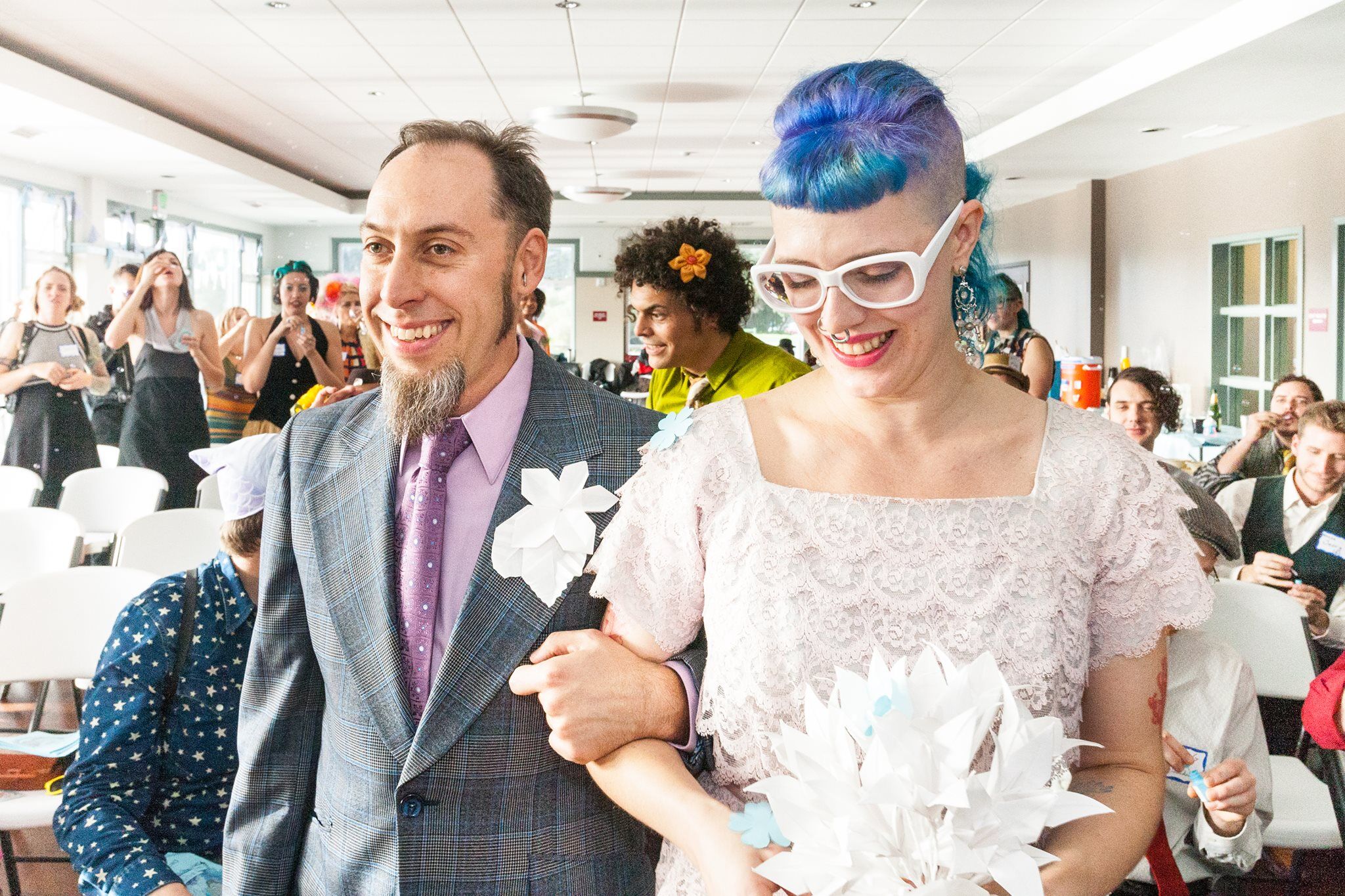
Colin and Tess: photos by Shalaco Wordsmith
Examining Wedding Roles With A Wedding Roleplaying Game
One way to rethink wedding roles is to reassign them. In this vein, Colin Fahrion and Tess Aquarium got their silly on for a live action role-playing (LARP) wedding that totally surprised all their guests.
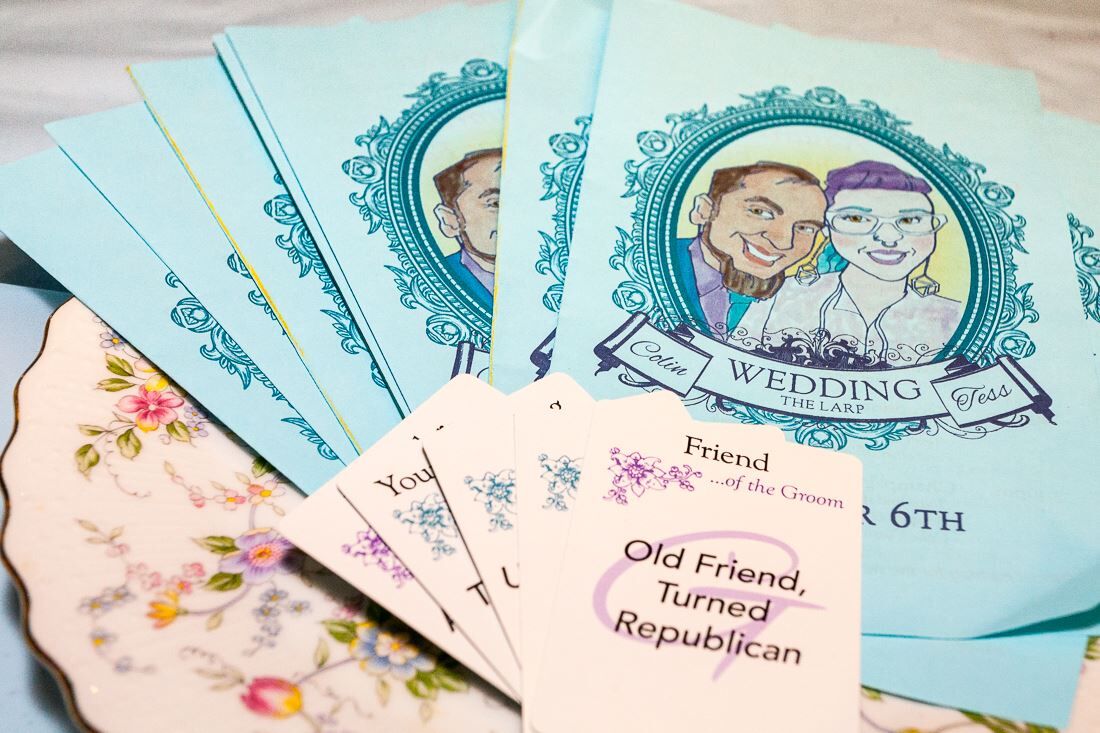
Photo by Shalaco Wordsmith.
Tess and Colin’s guests were expecting a holiday party, and they wore playful costumes. Yet after they arrived at San Francisco’s Lake Merced Boathouse on a December day in 2014, they each were instructed to choose a wedding “player card.” One lucky friend received the officiating minister card, and thereby got to stand in front of the room and lead the ceremony. Another friend picked caterer, and was shown where the party food was so they could serve it. Others were transformed through the magic of make-believe into “Old Friend Turned Republican,” “BFF,” “Overly Excited Kid,” “Parent of the Groom,” and other essential nuptial attendees. The cards were gender-neutral, which meant that Colin ended up wth two gay dads after two men drew the “Colin’s parent” cards.
During the ceremony, the minister read a Mad Libs-style wedding speech, which was assembled from audience suggestions. The ring-bearer brought a moment of utter hilarity when he lost the origami paper rings, and finally found them after pulling down his pants to search. One of Colin’s dads got really into his role and obtrusively filmed the whole thing on an iPad (as dads do), while a celebratory mosh pit post-ceremony pushed the limits of everyone’s tightly sewn seams.
#weddinglarp exploded over social media soon afterward. “It was basically a giant ridiculous shit show!” Tess wrote on her blog.
#weddinglarp exploded over social media soon afterward. “It was basically a giant ridiculous shit show!” Tess wrote on her blog.
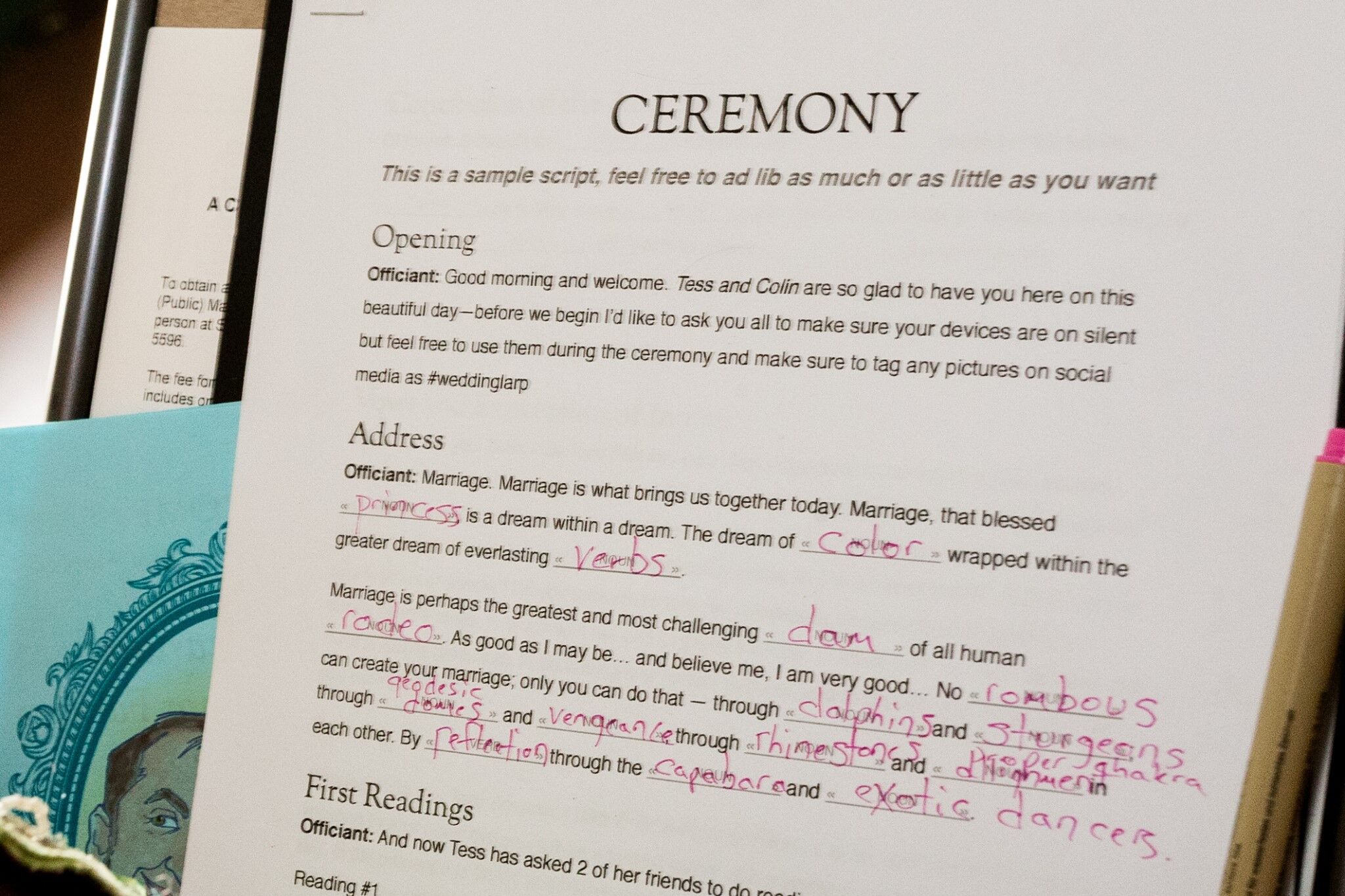
Photo by Shalaco Wordsmith.
Admitting she was nervous before the party, Tess also wrote that the silliness allowed her to truly enjoy the occasion. “As soon as we started walking down the aisle and I saw everyone jumping and cheering in a cloud of bubbles and paper flower petals, I started smiling and laughed the entire ceremony.”
The program for the event included instructions for how to play the LARP game — everyone was encouraged to stay in character and act their roles as much as they wanted to, until the cake was cut. This was the guiding principle for the game, but it could also have applied to Colin and Tess’s attitude toward partnership: “Follow the first rule of improv: ‘Say Yes.’”
This type of wedding might be a challenge for a typical wedding planner, but Tess and Colin were already well-practiced with LARP gaming — as Tess put it, “One of the reasons we chose to be life partners is because we creatively collaborate together really well! Both of us have a history of event production and planning, so throwing something with a surprise aspect and unusual logistical needs is our idea of a good time.”
The cards and instructions were eventually turned into a bona fide LARP game, which can be purchased on Tess and Colin’s website.
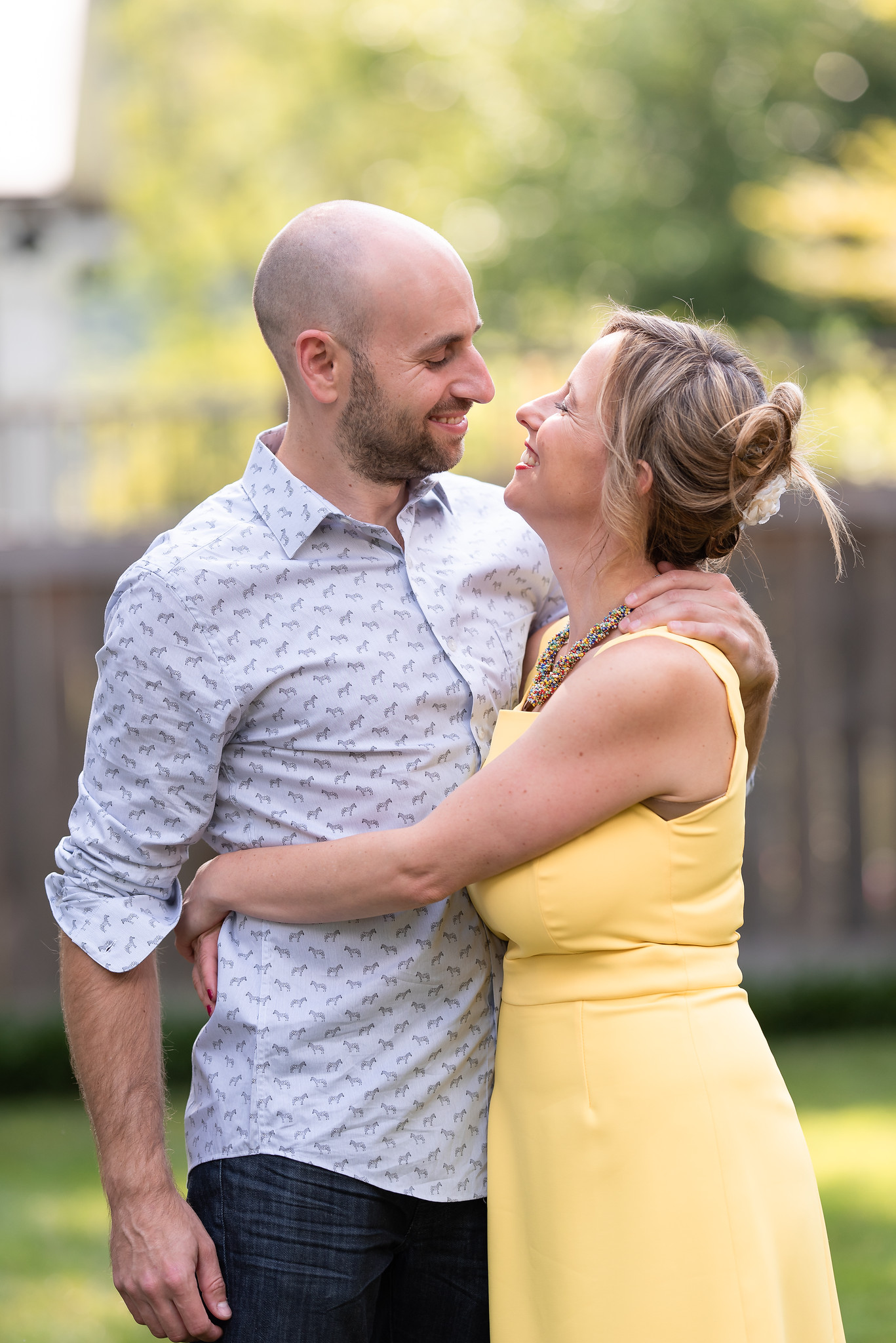
Kristen and Phil. Photo by John Kuta.
Design Principles: Rethinking the Wedding Script From Scratch
Kristen Berman runs a successful behavioral science startup. She’s used to seeking solutions for different populations based on behavioral economics insights, which often involves going back to first principles to find a solution. She told me that they wanted to heavily edit the script American culture writes for weddings, and this desire informed her “wedding” to Phil Levin in August 2018.
“Phil and I try to design our lives following first principles, so we did the same for our ceremony,” Kristen said. “For example, most weddings try to solve for too many people. Friends, family, the couple. So we split up the groups and had an intimate immediate family ceremony in Phil’s parents’ home where we felt close with everyone.” The couple intends to host a separate friends-centered event, which they are still planning.
Kristen and Phil noted that the bride and groom typically don’t speak much during weddings, yet everyone is curious about what they have to say. So the couple decided to occupy the stage with an hour-long PowerPoint presentation about their relationship, past, and future. They detailed their thinking about money, and their perspective on living in their innovative cohousing community, where they are building an extended intentional family of close friends who live together. They even took nosy questions from the family members in their audience, along the lines of: “How are you going to keep each other happy?” and “When will you have kids?”
Instead of vows, they reiterated their first principles, which included valuing their other relationships outside their partnership, avoiding materialism, and not taking themselves too seriously.
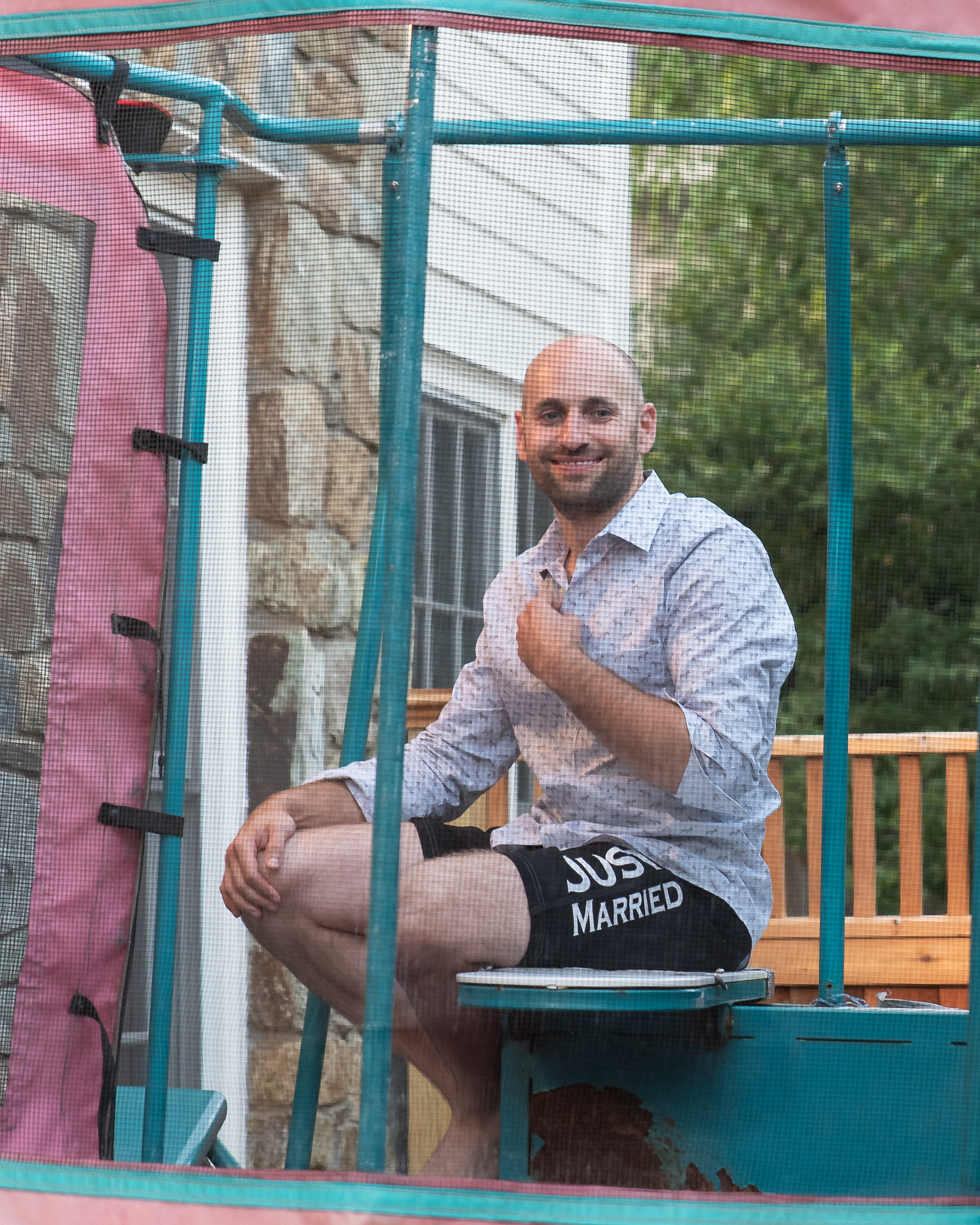
Photo by John Kuta
Kristen’s sister was ready to underscore the final principle, and ushered the couple outside to a surprise dunk tank. The pair wiggled out of their dressy casual outfits (a yellow frock for her, a plaid shirt and slacks for him) into “bride” and “groom” swimsuits, and gamely waited for their dearest relatives to pitch them underwater.
Was it a wedding? Phil and Kristen don’t like to think so — they think the word “wedding” carries a lot of heavy baggage with it. “People expect certain things, and thus are surprised or let down when the script deviates,” Kristen said. So, to avoid this baggage, Kristen and Phil called their ceremony a “family gathering.” No rings, no marriage certificate, no fancy napkin holders, no wedding invites, no sign-in book. By designing for their authentic tastes and desires, they had a meaningful party in which they were able to interact with everyone present, yet it included few of the usual wedding signifiers.
At age 35, Kristen and Phil had already built successful careers and made the big decisions about where they wanted their lives to go. Because of tax disadvantages, they didn’t even make their commitment bureaucratically official: they are not legally married. (In the US, a legally married couple with roughly equivalent and high enough incomes will be obliged to pay more taxes than if they were legally single. In contrast, a legally married couple with a large gap between their incomes will typically gain a tax advantage. These laws reflect social engineering efforts from decades ago, and were instituted long before the current era of women routinely earning as much as their male partners, much less same-sex marriage and other recent changes.)
Kristen and Phil’s wedding is an example of the fact that a wedding is no longer the first step in adulthood, as it may have been in generations past. In fact, their marriage was almost the last step. They hosted an event to celebrate what they had already done together, and what they would be continuing.
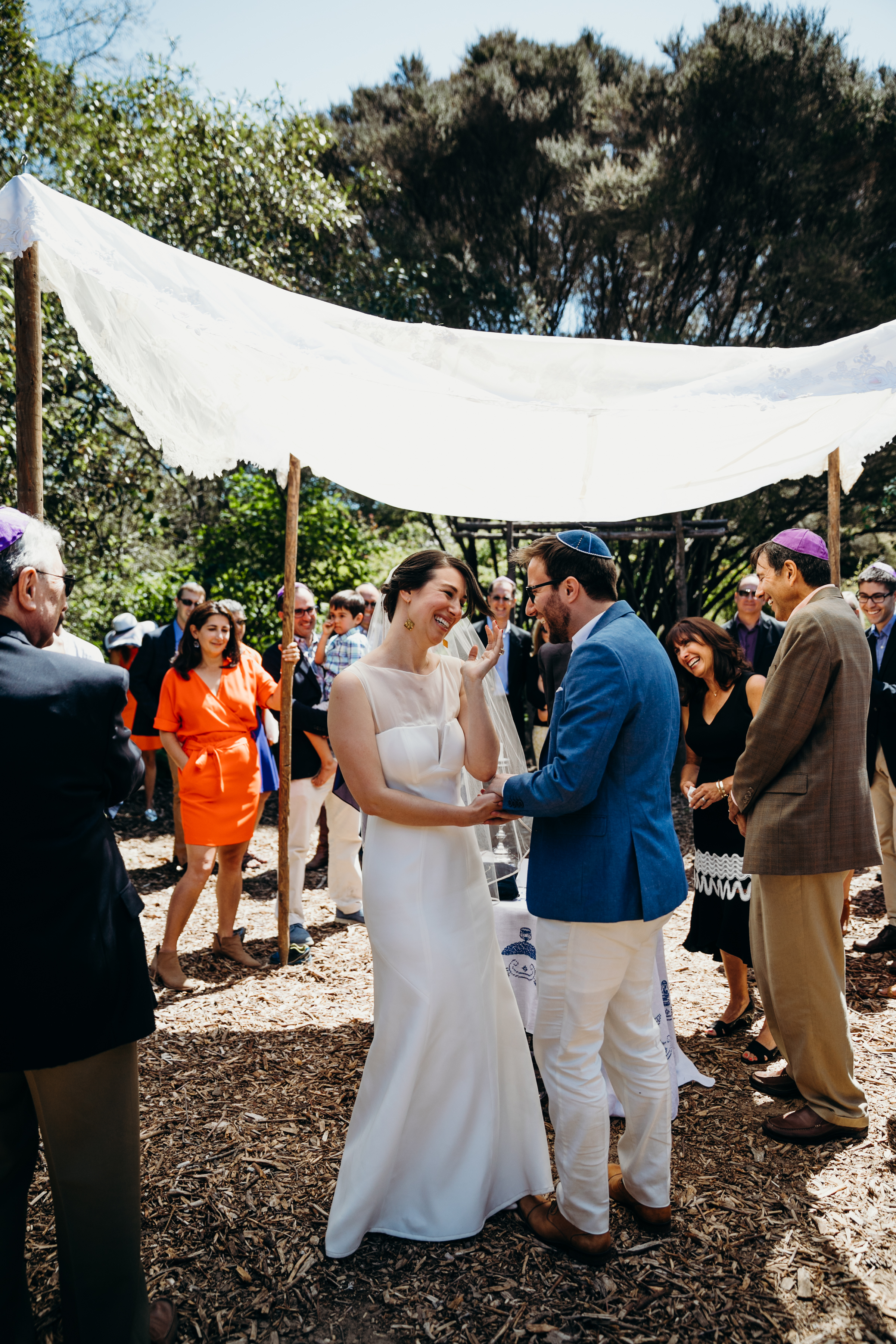
Randy and Avital. Photo by Katie Edwards.
Business Organization Principles Applied To Marriage
When Kristen and Phil gave their wedding PowerPoint presentation, one question from the audience was, “What are the KPIs for your marriage?” (For those not initiated in tech industry vocab, that means “key performance indicator.” KPIs are metrics that some businesses use as concrete indicators of progress.)
The question got a laugh, but it wasn’t because the idea of applying business principles to a romantic partnership is absurd. In fact, more and more couples steeped in tech innovation are taking best practices from their work and using them to enhance how they communicate, set goals, follow through, and celebrate success.
Randy and Avital Lubin got married in 2017. She runs a food tour company and he runs a gaming consulting firm. Ever motivated to succeed, the two use the project management software Asana (which was named after a yogic body posture) to plan most aspects of their lives, including their wedding. “We have annual and quarterly projects and goals [that are tracked in Asana],” said Avital. “Some we are working on together, and some are individual. We like to borrow best practices from startups.”
That includes creating a list of core values that guide their partnership. Top of the list is “kaizen,” the Japanese term for continuous improvement, which became a widespread business principle after it was popularized by Toyota. “We considered changing our middle names to Kaizen,” said Avital, who then explained that the process for changing middle names is much more difficult than changing last names.
When planning their small wedding ceremony, which took place at a goat farm near Pescadero, CA, they integrated some traditional elements from Jewish weddings, but with many individual twists imbued with their core values. Along with pragmatic optimism, build for impact and persistent curiosity, they believe in nurturing connections. “We created a little card for each of the guests that had suggestions for other people they should chat with, and what they had in common. We wanted to be socially insightful,” said Randy.

Randy and Avital reading their core values. Photo by Katie Edwards
They said their example inspired other couples to figure out their core values that would allow them to make their weddings more authentic. Now two years into marriage, they are still going strong with their (non-yoga) Asana practice. “Every Sunday we have our weekly planning meeting and we allow time for our emotional interpersonal check in,” said Avital. Even their weekends are scheduled into goal-oriented chunks. “We timeblock cleaning up the house or working on our projects.” The two are avid game designers, so they also allot time for digital creativity. The planning system is ultimately about helping them achieve their dreams, like a three-month stay in Tokyo, which they recently completed.
Some observers might lampoon this high-touch, high-maintenance, and highly organized approach to an organic relationship, but there’s something super smart about starting out with core principles that the couple know they will regularly return to and re-evaluate.
“All we have to do is say ‘compassionate communication’ to each other if we feel like we’re getting off track,” Avital said. “It gets us on the same page really quickly.”
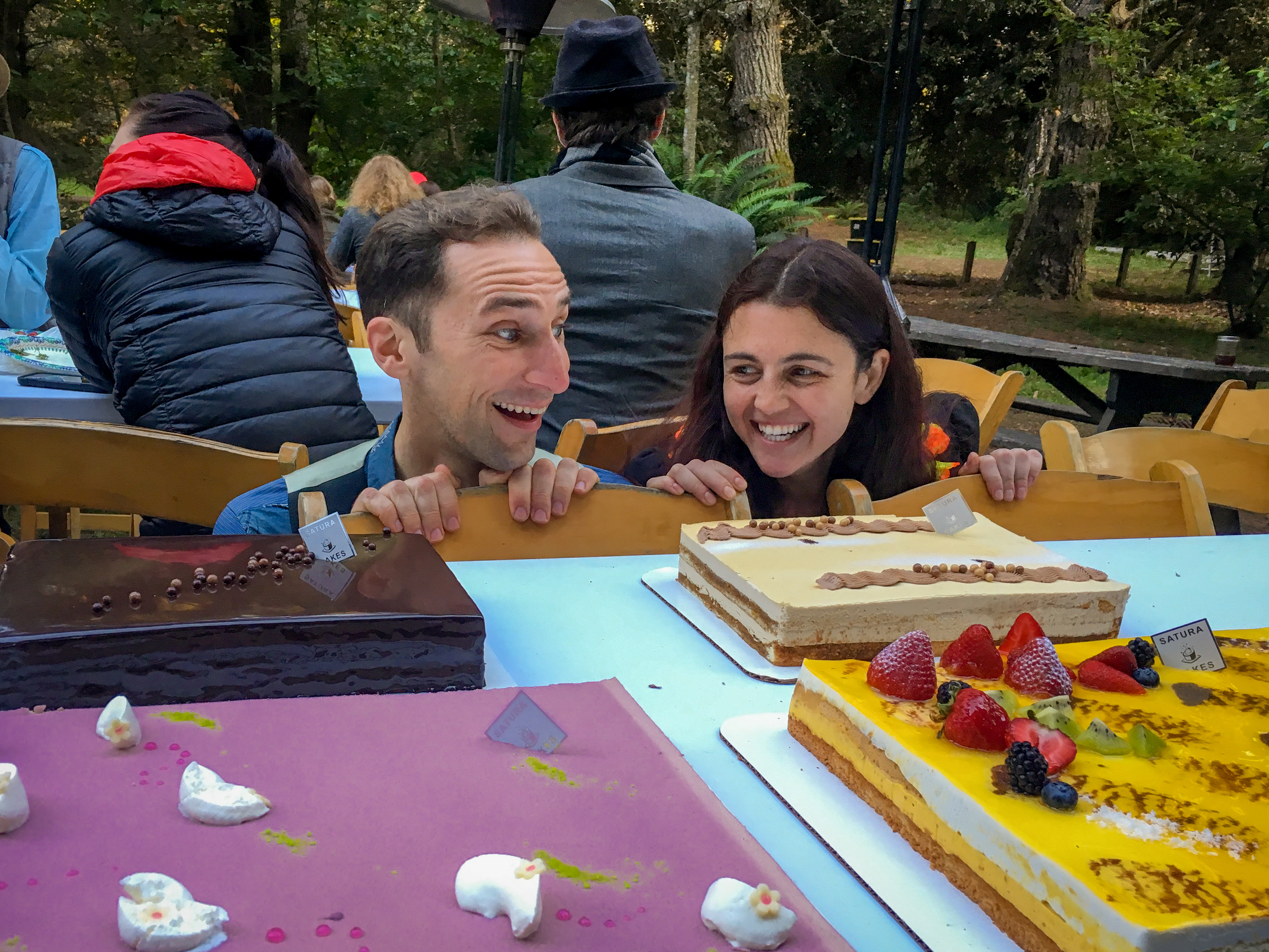
Matt and Helen. Photo courtesy of the couple.
A Co-Created, Commitment-Themed Festival of Revelation
When Matt Bell, co-founder of computer vision startup Matterport, and Helen Lurie, a manager at Lyft, decided to get married, they wanted to distribute the focus of the event instead of making it all about them. After much deliberation, they realized that they wanted to spur reflection on the long-term commitments that everyone important to them had made, and they also wanted to create an event that brought their community closer together.
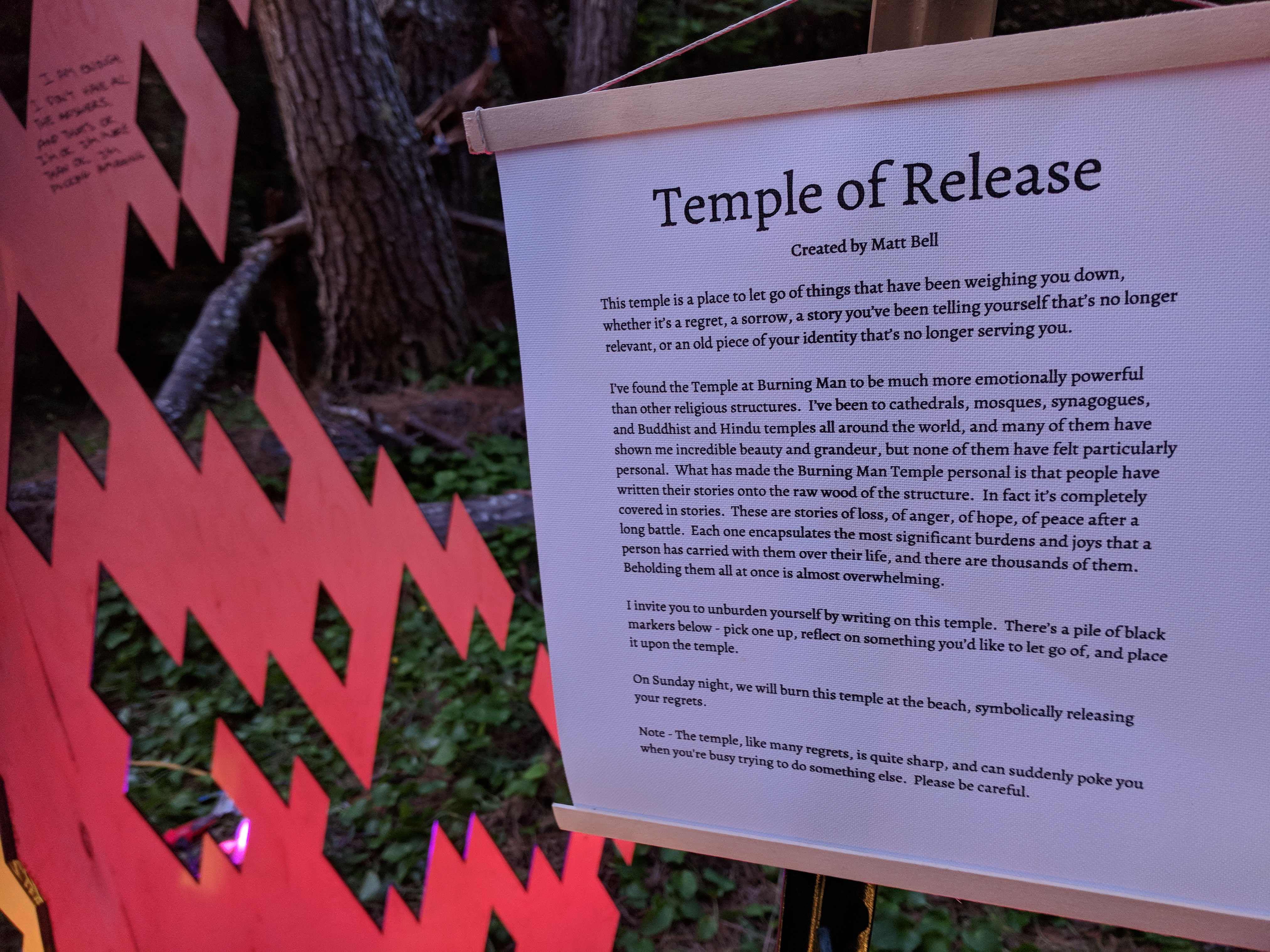
Photo courtesy of Matt and Helen
Coming from the culture of Burning Man, co-creation was their central inspiration. (Two of the core Ten Principles of Burning Man are “Participation” and “Communal Effort.”) So, instead of putting on a show, the couple rented a Mendocino coastal estate for a weekend in June 2018, and encouraged guests to stay for multiple days while volunteering to enable a part of the event. Most guests camped, which brought down the cost.
There was a healthy skepticism about wedding dresses, wedding jewelry, and professional caterers: the bride wore red, there were no rings, and attendees volunteered in shifts to cook most meals, as well as volunteering for other logistical and creative projects. Since everyone was part of making the weekend happen, a DIY ethos emerged that, in Matt’s words, allowed their event “to avoid the wedding-industrial complex almost entirely.” Afterward, Matt wrote an article on Medium describing the power of this co-creation: “There’s a certain shift that happens when everyone feels responsible for making something go well — it’s a mix of trust and mutual gratitude that emerges.”
On the final night of the weekend, the group burned a wooden art piece Matt had built and named the “temple of release,” in a ritual similar to the Temple Burn that happens on the final night of Burning Man.
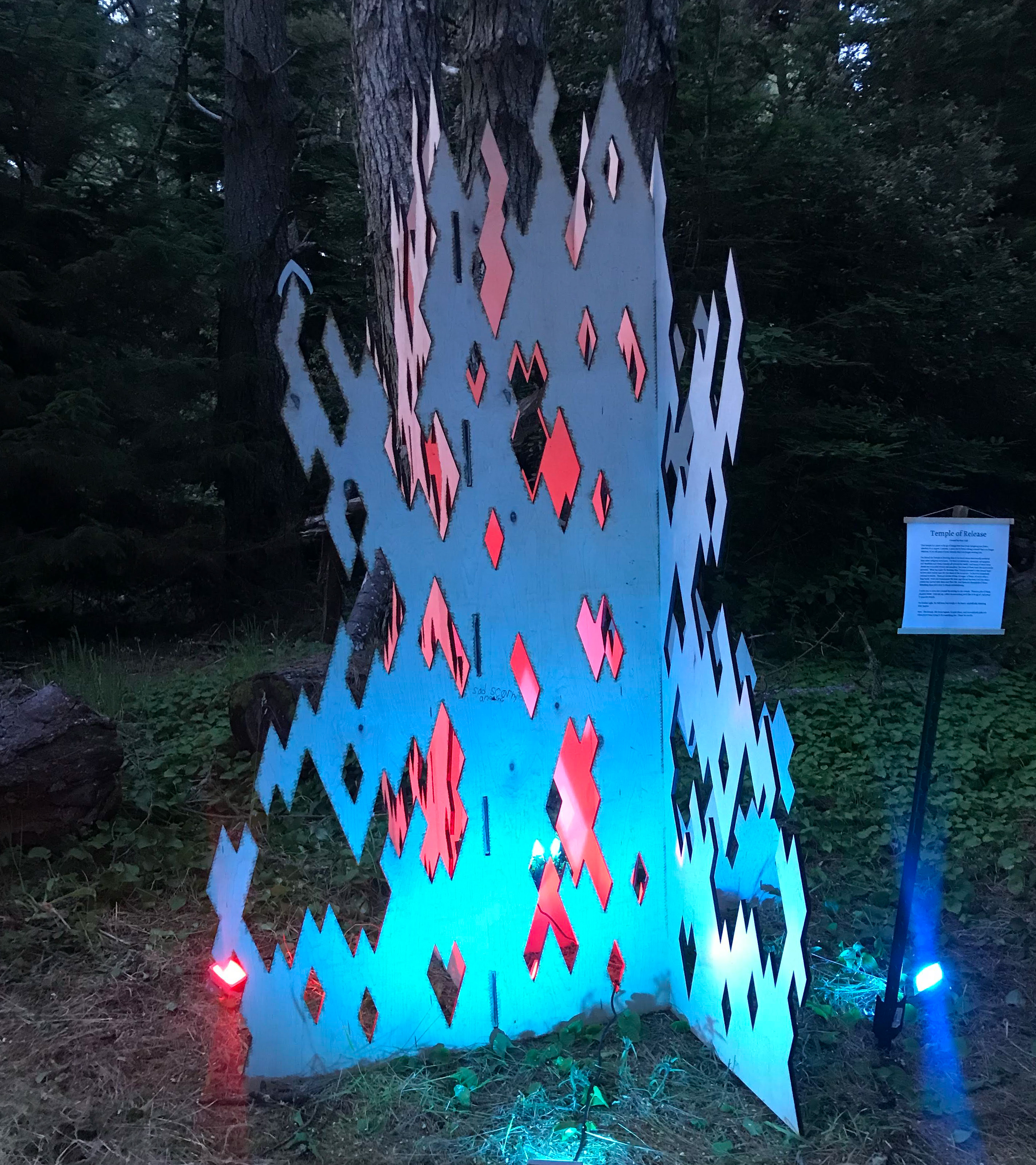
Photo courtesy of Matt and Helen.
Their weekend included a guided journey in nature that prompted participants to reflect deeply on what they want out of life; morning talks about a variety of topics, from yoga to real estate investing; group meditation; and large art displays reminiscent of Burner art. On the final night of the weekend, the group burned a wooden art piece Matt had built and named the “temple of release,” in a ritual similar to the Temple Burn that happens on the final night of Burning Man.
While a lot of weddings spark joy and tears for attendees, Matt and Helen heard that many of the people who joined their festival came to new insights and decisions about relationships or careers through the weekend offerings. Above all was the opportunity to make new meanings within community, which seems to be the theme tying these NewMo weddings together.
What We Learn About Marriage By Transforming Weddings
Back when I got married, I protested convention in order to be true to my eco-feminist convictions. I didn’t wait to be proposed to (I saw that as giving up my autonomy), I didn’t accept an engagement ring (we got a red couch instead), I wore a purple and gold dress (virginal white makes me look pasty), and we gave away compact light bulbs as wedding favors (because An Inconvenient Truth was all the rage). And no way in hell was I going to change my last name, even though his was more melodious. At the time, these choices seemed radical and even abrasive to some of our guests. Yet to others, these choices were a welcome and inspiring change.
Things will inevitably get rough for two people building a life together, but the hackneyed script of “for richer, for poorer, for better, for worse, in sickness and in health” is getting transformed by prioritizing core principles, design thinking, and community growth.
As radical as my wedding was at the time, however, I’ve learned a lot about creating new ritual from researching these NewMo weddings. Now, when I reflect on the innovations that these newlyweds brought to their partnership celebrations, I’m heartened to know that the realities of marriage are being more thoughtfully considered. Things will inevitably get rough for two people building a life together, but the hackneyed script of “for richer, for poorer, for better, for worse, in sickness and in health” is getting transformed by prioritizing core principles, design thinking, and community growth.
Rather than setting conventional text into indelible ink on parchment, we have the opportunity now, in this cultural moment, to create adaptable partnerships that get commemorated with balance and renewal built into the recipe for lasting love. But that’s all it is: a recipe. It’s not the meal. As my marriage has grown, matured, and changed in ways I couldn’t possibly have anticipated as a nearly-wed, I would love to go back and give myself some bridal advice.
Skip the wedding, I might say. In fact, maybe skip getting married officially. Spend all that time and money and emotional investment on your communication skills with your partner. Put a process in place to identify and express your feelings truthfully. Go on a vision quest. Spend some time apart. Write your mission statement and core values together. Learn couples massage. Talk to lots and lots and lots of people about what their marriages and partnerships have been like. Read the great works of literature about relationships that work and relationships that don’t.
Then, if it feels right, make a commitment that has an expiration date. Throw a party whenever you want! Forever is a long time. It’s too long a time to know who you and your special someone will have become when it’s halfway through. By putting in an expiration date, or several, you’ll have to choose to be with your partner over and over again.
Through exploring the importance of weddings, I’ve realized that my idea of a good one is an ongoing wedding. You’re always entering into partnership, you’re always celebrating it, you’re always thinking deeply about what it means to be together. In the modern era, you can always end it — yet you can always reinvent it, too.
Transparency Notes
This was written by Jessica Carew Kraft and edited by Lydia Laurenson. It wasn't fact-checked, but we double-checked quotes and descriptions with the community members whose weddings we profiled. For more about our transparency process, check out our page about truth and transparency at The New Modality.

